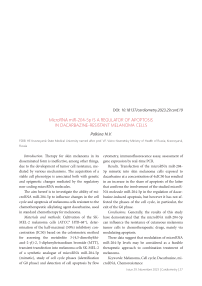MicroRNA MIR-204-5P is a regulator of apoptosis in dacarbazine-resistant melanoma cells
Автор: Palkina N.V.
Журнал: Cardiometry @cardiometry
Рубрика: Conference proceedings
Статья в выпуске: 29, 2023 года.
Бесплатный доступ
Therapy for skin melanoma in its disseminated form is ineffective, among other things, due to the development of tumor cell resistance, mediated by various mechanisms. The acquisition of a stable cell phenotype is associated both with genetic and epigenetic changes mediated by the regulatory non-coding microRNA molecules. The aim hereof is to investigate the ability of microRNA miR-204-5p to influence changes in the cell cycle and apoptosis of melanoma cells resistant to the chemotherapeutic alkylating agent dacarbazine, used in standard chemotherapy for melanoma.
Melanoma, cell cycle, dacarbazine, chemoresistance
Короткий адрес: https://sciup.org/148327391
IDR: 148327391 | DOI: 10.18137/cardiometry.2023.29.conf.19
Текст статьи MicroRNA MIR-204-5P is a regulator of apoptosis in dacarbazine-resistant melanoma cells
FSBEI HE Krasnoyarsk State Medical University named after. prof. V.F. Voino-Yasenetsky Ministry of Health of Russia, Krasnoyarsk,
Russia
Introduction . Therapy for skin melanoma in its disseminated form is ineffective, among other things, due to the development of tumor cell resistance, mediated by various mechanisms. The acquisition of a stable cell phenotype is associated both with genetic and epigenetic changes mediated by the regulatory non-coding microRNA molecules.
The aim hereof is to investigate the ability of mi-croRNA miR-204-5p to influence changes in the cell cycle and apoptosis of melanoma cells resistant to the chemotherapeutic alkylating agent dacarbazine, used in standard chemotherapy for melanoma.
Materials and methods: Cultivation of the SK-MEL-2 melanoma cells (ATCC® HTB-68™), determination of the half-maximal (50%) inhibitory concentration (IC50) based on the colorimetric method for assessing the metabolite 3-(4,5-dimethylthi-azol-2-yl)-2, 5-diphenyltetrazolium bromide (MTT), transient transfection into melanoma cells SK-MEL-2 of a synthetic analogue of microRNA miR-204-5p (mimetic), study of cell cycle phases (identification of G0 phase) and detection of cell apoptosis by flow cytometry, immunofluorescence assay, assessment of gene expression by real-time PCR.
Results . Transfection of the microRNA miR-204-5p mimetic into skin melanoma cells exposed to dacarbazine at a concentration of 4xIC50 has resulted in an increase in the share of apoptosis of the latter that confirms the involvement of the studied microR-NA molecule miR-204-5p in the regulation of dacar-bazine-induced apoptosis, but however it has not affected the phases of the cell cycle, in particular, the exit of the G0 phase.
Conclusions . Generally, the results of this study have demonstrated that the microRNA miR-204-5p can influence the resistance of cutaneous melanoma tumor cells to chemotherapeutic drugs, mainly via modulating apoptosis.


